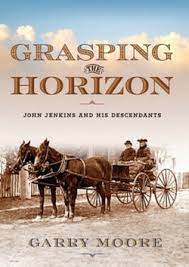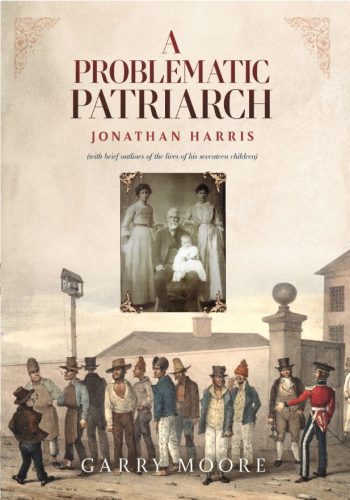I am lucky enough to have a number of cousins who are just as interested in the family history as I am. It is a wonderful thing to meet these cousins as we know we will always have something to talk about. One such cousin is Garry Moore who has managed to put together two publications on perhaps the two most “interesting” of our shared family members. Garry’s first book was Grasping the Horizon about the John Jenkins (1781-1886) dynasty. The Jenkins family came from East Malling in Kent, with John Jenkins being the first to reach Australian shores, albeit against his will. He spent most of his life in the Berrima district and after a family reunion, son Frank moved to Buckingbong near Narrandera, carving out an empire of land and cattle. Son Jack and other family members also moved away from the family base to take up land. The Jenkins story was not merely a story of “hail the conquering hero comes” however. It was also one of power and disposession, of loss, of hatred, and ultimately, of atrocities of such a nature that it is difficult for us to imagine. Specifically, the Jenkins sons were involved in the so called Wiradjuri War located around Murdering Island of New South Wales in the late 1830s. As relatives of perpetrators how do we sit with this knowledge? I don’t know. But it must sit – in our consciousness, in our collective, in our psyche. It must sit and be laid bare to the gaze of all, not hidden away in shadows and whispers. It must be examined and become part of our story.
The direct ancestor of Garry and I in the Jenkins family was Elizabeth the sister of John Jenkins (1781-1886) who died in Wangaratta in 1849. She was the mother of William Henry Clark of Wangaratta, John Clark of Seymour and ‘Gooparle’, Flemington, and Richard Clark of Benalla, amongst others. Grasping the Horizon was published in 2021 and is available on Booktopia.
Garry’s most recent book is A Problematic Patriarch.
“The convict’s plea in mitigation was one of misfortune, abandonment, abuse, neglect and destitution: human flotsam and jetsam caught in the massive transformation of the industrial and agricultural revolutions, the pursuit of empire and the insatiable hunger for land.” – Janet McCalman
The Problematic Patriarch was Jonathan Harris, convicted and transported twice, likely convicted several more times during his lifetime, married three times and father of 17 children. How did this humble ploughman and gardener from rural Sussex survive transportation and thrive in the brutal landscape of the Australian convict system? He became brutalised. Was he brutalised before? Likely. Jonathan certainly wasn’t keen on learning to keep his head down and staying out of trouble. Originally transported to New South Wales for life in 1825 for burglary, his wife Elizabeth Baker (my ancestor) was left behind in England with children Jonathan junior, Elizabeth Harris (my ancestor) and Henry, who likely wasn’t born when Jonathan was convicted. After a few years Elizabeth and the children were allowed to join Jonathan in New South Wales. The family seemingly picked up where they left off, with a further three children being born to Elizabeth before her death in a cart accident at Taralga in 1836. Jonathan went on to have two further marriages, not all of them happy. He and son Jonathan junior were sentenced to transportation to Tasmania for 15 years for robbery, leaving the second wife Ann Grubb pregnant with her second child, and in charge of four of Jonathan’s children from his first marriage. To add insult, all of Jonathan’s furniture was confiscated leaving Ann destitute. She intelligently removed herself from the relationship while Jonathan was in prison and remarried. In Hobart, Jonathan senior made good, at least on the family front. He snared a third wife in Mary Ann Squires, 26 years his junior. They went on to have 10 children, the youngest when Jonathan was 72 years old. By then the family had come full circle, moving back to the mainland where they settled at Benalla, possibly to be near the rich Wangaratta relatives of William Henry Clark and his wife Elizabeth who was Jonathan senior’s oldest daughter. Somehow this mainland sojourn miraculously washed away the convict stain and Jonathan became a respected townsperson – or folks were just polite in Benalla.
You can buy Garry’s book about Jonathan Harris here.
* For those wondering about the image on the cover of the book, yes, it has been well established that this is NOT an image of Jonathan Harris (1799-1891). Not only is this man not nearing his 90s, the image was also taken around the early 1900s, well after Jonathan had died. The inheritance of the original image suggests the man was one of Jonathan’s sons.







I believe Thomas perrin Jenkins, an adopted son and buried at Buckingbong station family cemetery. Is my mother June Jenkins great grandfather. She is the daughter of Thomas and Kate Jenkins (Sanderson) of Bourke
Hi, just wondering if you have evidence of that photo being taken in the early 1900s? My own research shows it was taken in the early 1870s.
Hi Jordan. The clothing is postively of the early 1900s era and absolutely not 1870s. If you can find Lenore Frost’s book called Dating Family Photos which delves into far more than just clothing it will be evident.